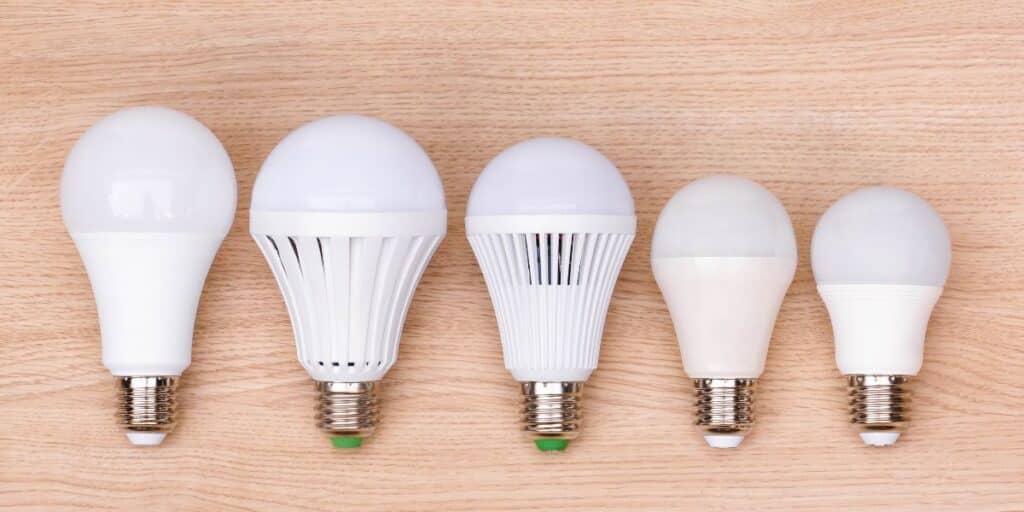Getting to Grips With Light Bulb Sizes
With so many different light bulb sizes available, it can be tricky to know which one is right for your fixture. What’s the difference between an SES-E14 and an ES-E27, and where does a bayonet fitting come in?
At IOS Lighting, we’re here to make things simple. Our easy-to-follow light bulb size guide explains the most common bulb types and fittings – helping you find the perfect match for your lights with confidence.
Do I Need A Bayonet Cap or a Screw Cap?
The first thing to get right when choosing a light bulb is the cap type. This is the part that connects the glass bulb to the light fitting. It determines whether your bulb will actually fit. There are two main types of bulb caps used in the UK: bayonet caps and Edison screw caps.
These two types are not interchangeable, so it’s important to identify the correct one before buying. Let’s explore the different light bulb sizes and fittings for each type.
What Is An Edison Screw Cap?
The Edison Screw fitting is named after Thomas Edison, the inventor of the light bulb. This cap has a threaded base that simply screws into the light fitting – a design that’s been in use since 1881 and remains one of the most common today.
What is an E27 Cap?
The E27 cap, also known as the Edison Screw (ES), is the standard bulb fitting used in most household lamps and ceiling lights. It has a 27 mm diameter and is one of the most common light bulb bases in the UK and Europe.
What is an E14 Cap?
The E14 cap, or Small Edison Screw (SES), is a smaller version of the Edison fitting, with a 14 mm diameter. It’s often found in decorative fittings, such as bedside lamps, chandeliers and wall lights where a more compact bulb is needed.
What is an E10 Cap?
The E10 cap, also known as the Miniature Edison Screw (MES), is the smallest of the Edison fittings, measuring just 10mm in diameter. These are typically used in small decorative lights, appliances or specialist fittings.
With all these different light bulb codes and sizes, it’s easy to see why having a clear guide to light bulb fittings can make choosing the right bulb so much simpler!

What Is A Bayonet Cap?
The bayonet cap, also known as the ‘twist and lock’ or ‘push and twist’ fitting, uses two small pins that slot into the socket and twist to lock into place. If your light doesn’t use a screw fitting, it’s almost certainly a bayonet.
What is a B22d Cap?
The B22d, also known as the Bayonet Cap (BC), is the standard bayonet fitting used in most UK homes. It has a 22 mm diameter and features a push-and-twist locking mechanism that securely connects the bulb to the socket.
This fitting is commonly used in ceiling lights, pendant fittings and table lamps.
What is a B15d Cap?
The B15d, or Small Bayonet Cap (SBC), is a smaller 15 mm version of the traditional bayonet fitting. It’s often found in wall lights, smaller lamps and decorative fixtures where a compact bulb is needed.
What is a BY22d or B22d-3 Cap?
There are also a few less common bayonet fittings, such as the BY22d and the three-pin B22d-3. These are typically used in specialised or industrial lighting applications and are not usually found in everyday household fittings.
What Are GU10 Lamps?
No guide to light bulb fittings would be complete without mentioning the GU10. These bulbs have two short pins with a twist-lock mechanism, technically making them part of the bayonet family.
What Does The GU10 Code Mean?
G – bi-pin base
10 – 10 mm distance between the pins
Originally designed for halogen spotlights, GU10s are now most commonly available as energy-efficient LED lamps. If your kitchen or bathroom has spotlights, chances are it uses GU10 bulbs.
Light Bulb Sizes Explained by iOS Lighting
We hope this guide helps you understand the different light bulb caps and sizes so you can find the perfect fit for your lighting. Once you know your fitting type, choosing a replacement or upgrade becomes much easier.
At IOS Lighting, we’re always happy to help with any lighting questions. Contact us today or visit our store for friendly, expert advice on finding the right bulb for your light.
